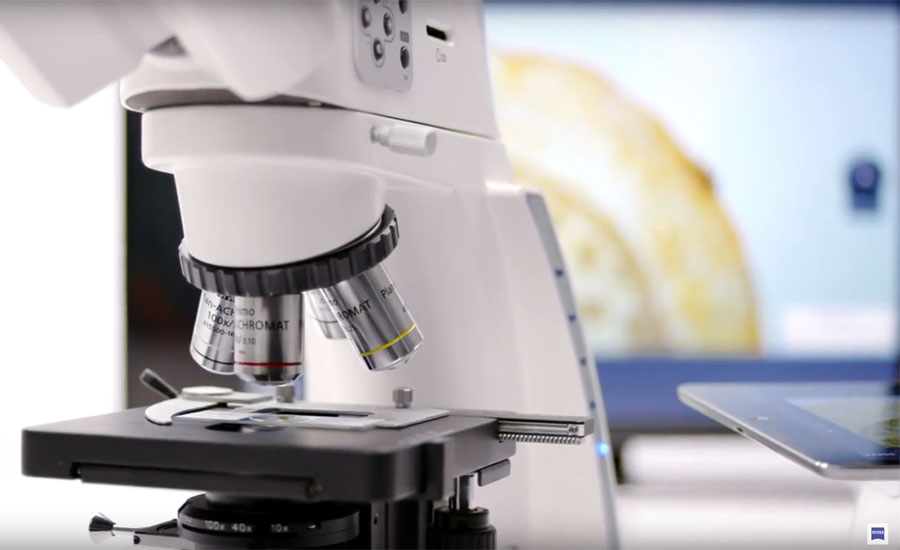The medical field is front and center right now. Whether it’s manufacturing new ventilators or analyzing virus particles, the importance of the medical industry has never been clearer.
When you think of medical applications, you may think of microscopes. Microscopes have long been associated with this industry, whether with the scientist in the lab or the manufacturer checking samples. While gathering the data is important, controlling it is even more so.
For the medical industry and many others, data integrity is increasingly important. More and more companies are requiring stricter control of their data, says Jim Yampolsky, industrial business development - applications specialist, ZEISS Industrial Quality Solutions.
“In medical device manufacturing and microscopy especially, more and more companies are wanting to be able to control the data that they are capturing. Software is becoming a key part of this,” Yampolsky says.
The FDA, for one, mandates this with the FDA 21 CFR Part 11 which requires companies to adhere to strict data policies.
Though the microscope technology itself is not new, there have been a number of innovations to keep up with changing customer needs. Not surprisingly, one of them is software. The right software system can drive hardware decisions and differentiate one system from another. Additionally the right software allows you to enable workflow oriented solutions. You find actionable data from your analysis reports and can drive decisions faster.
The ZEISS GxP is one such software. GxP is a general abbreviation for the "good practice" quality guidelines and regulations, whether this is GMP (good manufacturing practice), GLP (good laboratory practice) or GEP (good engineering practice).
Maintaining data integrity is invaluable for regulated industries such as aerospace, automotive, medical and nuclear. Manufacturers need to show that they have strict control of a process. While the GxP software previously seemed exclusive to medical companies, now it is branching out to other industries.
“This is a new focus for microscopy,” Yampolsky says. “It’s not just taking images and nice pictures. It’s gone to really taking data that is critical, the methodology and software solution to show that data has not been manipulated.”
Microscopy is evolving, he notes, and though getting an image is helpful, it’s more about the analysis and data from those images. In other words, the data handling and processing afterwards is even more important.
This dovetails with the growing trend of better data and better protected data. “More importance is being placed on the data being captured,” he says. “We’re seeing a lot of advancements in cameras, allowing us to take better images, collect better data. In the last couple of years, there’s much more emphasis on the data that we’re getting and the use of the data.”
The GxP module, part of the company’s ZEN Core software, allows users to control and meet requirements for maintaining electronic records. Though it is not a new module for ZEISS, Yampolsky notes that it is very new for the microscopy industry.
It could be used throughout the manufacturing process, for quality managers, lab managers and IT staff. It would allow control of electronic records, user management roles, an audit trail, versioning of documents and workflows, and disaster recovery in case of a hardware breakdown.
For example, a manager could electronically sign off on a decision but the system wouldn’t let them manipulate the routine used to collect the data. If centralized data management is something your organization needs, the module could help.
The GxP module is very specific, he notes, so a general user wouldn’t see it. It’s a process, not just having the software module, but also doing process qualification. The microscope is really just one part of it, he notes—and this microscope could be a scanning electron microscope or a more traditional one. The module can be used to give an extra level of confidence to manufacturers, who would be able to prove that data was collected and hasn’t changed or been manipulated along the way.

As Yampolsky points out, “A lot of customers don’t want their information to be shared with anyone.” Intellectual property is something manufacturers take very seriously, regardless of industry.
For the medical industry this control may be mandatory but other industries also have such critical components. Consider an aircraft component, or any other device with critical features.
FDA compliance will guide companies who aren’t on this path already. CFR Part 11 outlines how electronic records need to be stored and maintained. This shows that all of the signatures on a document can be linked back to data.
In terms of a general microscopy trend, he anticipates more use of digital microscopes, which has had a huge impact on microscopy in the past several years.
Having a digital microscope simplifies the process so the user wouldn’t need as deep of an understanding of the process. And the future of microscopy looks even simpler, according to Yampolsky. This would involve a user capturing the final result without extensive input.
“It’s really just more immediately getting to the final result without a lot of manipulation,” Yampolsky says, noting that systems that can do this are coming down the technology pipeline.
“That’s the goal,” he says, “Walk up to the system, put the part under it and see what I need without a lot of manipulation.”

